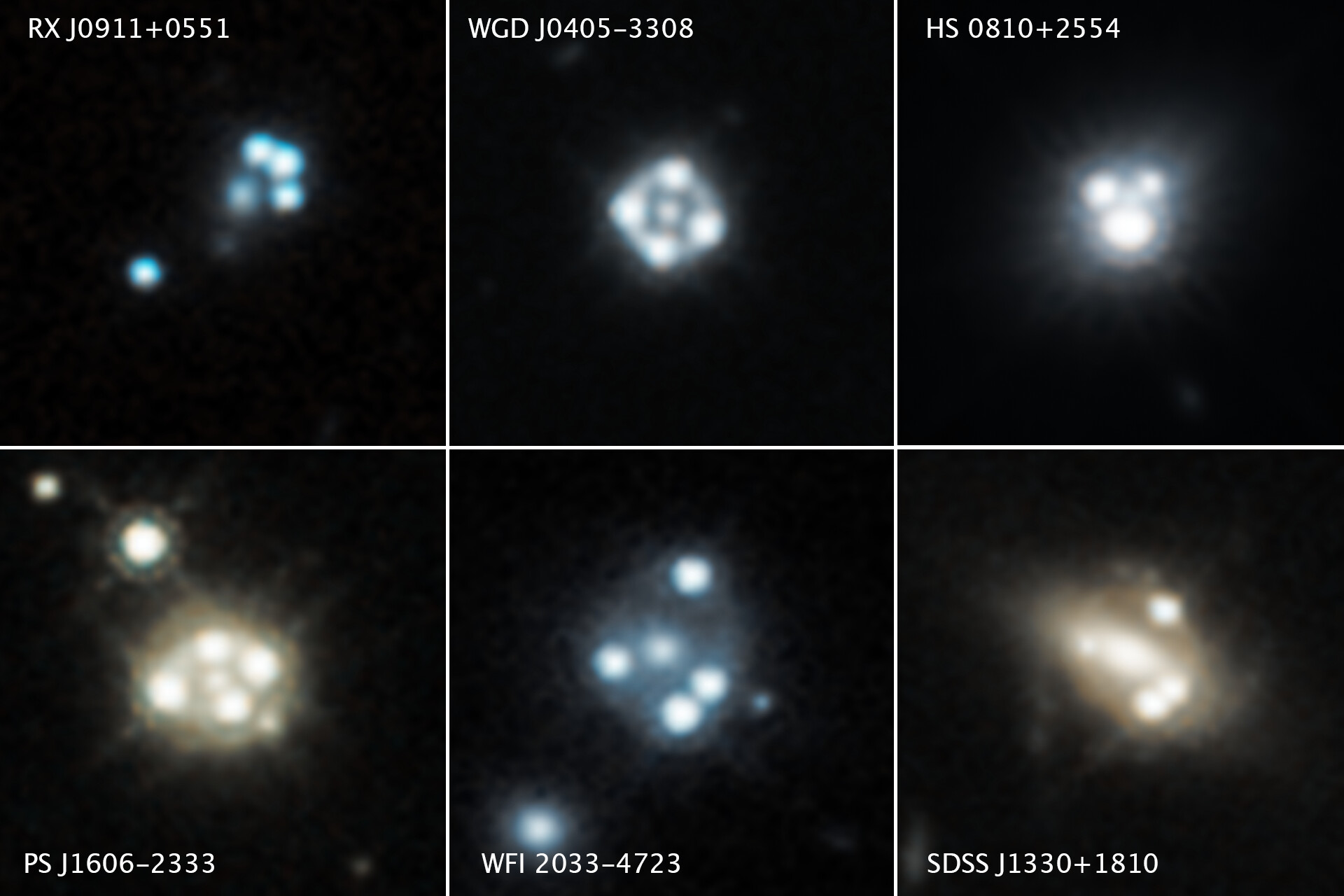Gravitational lensing is a fascinating phenomenon that happens because of the way gravity works according to Einstein’s theory of General Relativity: mass curves spacetime. Imagine you have a massive object, like a star or a galaxy, sitting in space. This object has a strong gravitational pull, which means it will bend spacetime and – since light follows a path along this now bent space – it also bends the path of light that passes nearby.
When light from a distant object travels through space and comes close to this massive object, its path gets deflected by the object’s gravity. This bending of light is what we call gravitational lensing. Matter acts like a giant lens, and if the geometry is just right, like a huge magnifying glass in space!
The gravitational lensing effect can create some interesting and beautiful optical illusions. It can make distant objects appear larger or distorted, as if they’re being magnified or stretched. Sometimes, if the alignment is just right, it can even create multiple images of the same object, where the light of the object reaches us along several paths bent by a more complex mass distribution.

Euclid will capture highly detailed images of billions of galaxies using its visible instrument (VIS). One of its primary methods to determine the distribution of mass and dark matter across the Universe is to measure how gravitational lensing alters the perceived shapes of these galaxies. While in the quasar example above the distortions caused by lensing due to a massive galaxy in the foreground are large, and we see multiple images, the effects from less massive structures may be very small and imperceptible in individual images. However, a mass coherently impacts the apparent shape and orientation of background galaxies in a very small but systematic manner: an effect known as ‘weak lensing’. By scrutinizing images of numerous galaxies across a region, scientists can statistically detect this distortion, and can calculate where the distorting mass is located, and how massive it is. And since mass is mass, independent of being a star, gas, or dark matter, this method can also detect mass that can not be directly seen with telescopes – dark matter.

These exciting measurements expected from the Euclid mission bring a big challenge: extremely accurate measurements of galaxy shapes for more than a billion galaxies. Euclid scientists need to be able to determine for a galaxy that, say, is round, if the diameter is really the same in all directions by better than about 0.2%. This is the same as the difference in shape between Earth and the Moon – measured from a noisy photo with just a few pixels across.
And that’s not where the complications end. For this to work, the scientists need to accurately identify all the other factors – aside from lensing – that can impact the observed shapes of galaxies. Firstly, Euclid scientists must consider instrumental effects. When a galaxy is observed through a telescope, its image will get somewhat spread out and appears blurred due to various factors like the telescope’s optics, stability of the telescope’s pointing in space, detector effects, and internal scattering of light. Although Euclid has been designed to minimize these distortions, understanding and properly accounting for them is crucial for obtaining reliable results.
Another significant challenge arises from the fact that galaxies are not just spherical or round, but have their own intrinsic shapes and alignments in space. Furthermore, the observed shapes are not solely influenced by gravitational lensing but galaxies close to each other can also have a common evolutionary history and can have a similar history of interaction with massive structures in their vicinity. These so-called ‘tidal effects’ or ‘intrinsic alignment’ can introduce a systematic orientation of galaxies close to each other that mimics the lensing signal, making a proper consideration of intrinsic alignment vital during data analysis. Euclid scientists have been tirelessly working over the past years to develop accurate models for these contaminants, ensuring that Euclid can extract the true weak lensing signal and uncover a wealth of valuable insights into the mysteries of our Universe.
Gravitational lensing offers a unique opportunity to explore the fundamental nature of gravity and acquire valuable insights into the properties of the matter that acts as a lens in the process. Euclid combines the two essential capabilities for exploiting this method like never before. From space, it has an extremely clear view onto galaxies, unobstructed by the Earth’s atmosphere as for ground-based telescopes, and the ability to survey a huge area, more than a third of the sky. This is several 100 times wider than previous space observatories like the Hubble Space Telescope. Using the weak lensing technique with Euclid holds great potential in testing Einstein’s theory of General Relativity, our present understanding of gravity. Additionally, it opens a window to gain understanding about the enigmatic dark matter component of the Universe, which cannot be directly observed in any other way.
Are you captivated by gravitational lensing? Try the interactive tool The Hunt for Dark Matter, conceived by Shaun Hotchkiss.



